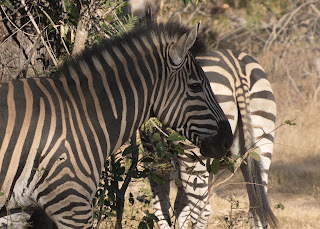There is hype surrounding the "Big Five." While we saw and photographed all of those species, which are exciting, so are some of the less ferocious and/or smaller animals and birds. This blog entry shares some of the images of these denizens of the bush.
I love the long legged, long necked giraffes, each with a distinct pattern of brown and beige. Look how the pattern swirls, cowlick like, on the neck of the giraffe in the image below. That is a red-billed oxpecker looking for insects.
The oxpeckers have a symbiotic relationship with numerous animals of the brush. The birds find food on the hide of the animals and the animals, such as giraffes and Cape Buffalo, find relief from the insects from the birds. This same pattern is common in Yellowstone with cowbirds on the bison. The oxpeckers, however, are much more interesting looking birds.

Zebras often hang out with giraffes. They provide protection and warning to each other and they do not compete for forage as they browse at different levels of the bush.
 |
| Plains zebras, note the tan coloration and stripes continuing around the belly |
Spotted Hyenas are not among the Big Five, but they are tough predators, Among predators, the Spotted Hyenas are second in size to lions.

The little domestic scene here belies their fierce predatory skills. The young pups rolled and chased and wrestled with each other like domestic puppies, and sought attention from both parents.
Members of the antelope family are the main prey for the hyenas, lions, and leopards. Impala, the super stars of the speed division are as common as deer in many areas of the US. And while they may seem common place to the guides and locals, they are beautiful animals as you can see in some of the images below.
 |
| Impala buck |


 |
| Steenbok, a tiny, delicate animal |
 |
| Nyala with elegant markings. |
And finally, a female kudu
|
 |
| Dwarf Mongoose. |
 |
| Hippopotamus and two kinds of herons. The grey heron is easy to spot. The Goliath Heron is visible behind the tree. |
 |
| How would you like this greeting you when you walked out of your tent? This is a Vervet Monkey |
 |
Wart Hog
|
 |
| crocodile |
 |
water monitor. There is nothing to give scale here but he was
several feet long |

























































